Instructor’s Manual:
Exercise Solutions
for
Artificial Intelligence
A Modern Approach
Third Edition (International Version)
Stuart J. Russell and Peter Norvig
with contributions from
Ernest Davis, Nicholas J. Hay, and Mehran Sahami
Upper Saddle River Boston Columbus
San Francisco New York
Indianapolis
London
Toronto
Sydney
Singapore
Tokyo Montreal
Dubai Madrid Hong Kong Mexico City Munich
Paris Amsterdam Cape Town
�
Editor-in-Chief: Michael Hirsch
Executive Editor: Tracy Dunkelberger
Assistant Editor: Melinda Haggerty
Editorial Assistant: Allison Michael
Vice President, Production: Vince O’Brien
Senior Managing Editor: Scott Disanno
Production Editor: Jane Bonnell
Interior Designers: Stuart Russell and Peter Norvig
Copyright © 2010, 2003, 1995 by Pearson Education, Inc.,
Upper Saddle River, New Jersey 07458.
All rights reserved. Manufactured in the United States of America. This publication is protected by
Copyright and permissions should be obtained from the publisher prior to any prohibited reproduction,
storage in a retrieval system, or transmission in any form or by any means, electronic, mechanical,
photocopying, recording, or likewise. To obtain permission(s) to use materials from this work, please
submit a written request to Pearson Higher Education, Permissions Department, 1 Lake Street, Upper
Saddle River, NJ 07458.
The author and publisher of this book have used their best efforts in preparing this book. These
efforts include the development, research, and testing of the theories and programs to determine their
effectiveness. The author and publisher make no warranty of any kind, expressed or implied, with
regard to these programs or the documentation contained in this book. The author and publisher shall
not be liable in any event for incidental or consequential damages in connection with, or arising out
of, the furnishing, performance, or use of these programs.
Library of Congress Cataloging-in-Publication Data on File
10 9 8 7 6 5 4 3 2 1
978-0-13-606738-2
0-13-606738-7
ISBN-13:
ISBN-10:
�
Preface
This Instructor’s Solution Manual provides solutions (or at least solution sketches) for
almost all of the 400 exercises in Artificial Intelligence: A Modern Approach (Third Edition).
We only give actual code for a few of the programming exercises; writing a lot of code would
not be that helpful, if only because we don’t know what language you prefer.
In many cases, we give ideas for discussion and follow-up questions, and we try to
explain why we designed each exercise.
There is more supplementary material that we want to offer to the instructor, but we
have decided to do it through the medium of the World Wide Web rather than through a CD
or printed Instructor’s Manual. The idea is that this solution manual contains the material that
must be kept secret from students, but the Web site contains material that can be updated and
added to in a more timely fashion. The address for the web site is:
http://aima.cs.berkeley.edu
and the address for the online Instructor’s Guide is:
http://aima.cs.berkeley.edu/instructors.html
There you will find:
• Instructions on how to join the aima-instructors discussion list. We strongly recom-
mend that you join so that you can receive updates, corrections, notification of new
versions of this Solutions Manual, additional exercises and exam questions, etc., in a
timely manner.
• Source code for programs from the text. We offer code in Lisp, Python, and Java, and
point to code developed by others in C++ and Prolog.
• Programming resources and supplemental texts.
• Figures from the text, for making your own slides.
• Terminology from the index of the book.
• Other courses using the book that have home pages on the Web. You can see example
syllabi and assignments here. Please do not put solution sets for AIMA exercises on
public web pages!
• AI Education information on teaching introductory AI courses.
• Other sites on the Web with information on AI. Organized by chapter in the book; check
this for supplemental material.
We welcome suggestions for new exercises, new environments and agents, etc. The
book belongs to you, the instructor, as much as us. We hope that you enjoy teaching from it,
that these supplemental materials help, and that you will share your supplements and experi-
ences with other instructors.
iii
�
�
Solutions for Chapter 1
Introduction
1.1
a. Dictionary definitions of intelligence talk about “the capacity to acquire and apply
knowledge” or “the faculty of thought and reason” or “the ability to comprehend and
profit from experience.” These are all reasonable answers, but if we want something
quantifiable we would use something like “the ability to apply knowledge in order to
perform better in an environment.”
b. We define artificial intelligence as the study and construction of agent programs that
perform well in a given environment, for a given agent architecture.
c. We define an agent as an entity that takes action in response to percepts from an envi-
ronment.
d. We define rationality as the property of a system which does the “right thing” given
what it knows. See Section 2.2 for a more complete discussion. Both describe perfect
rationality, however; see Section 27.3.
e. We define logical reasoning as the a process of deriving new sentences from old, such
that the new sentences are necessarily true if the old ones are true. (Notice that does
not refer to any specific syntax oor formal language, but it does require a well-defined
notion of truth.)
1.2 See the solution for exercise 26.1 for some discussion of potential objections.
The probability of fooling an interrogator depends on just how unskilled the interroga-
tor is. One entrant in the 2002 Loebner prize competition (which is not quite a real Turing
Test) did fool one judge, although if you look at the transcript, it is hard to imagine what
that judge was thinking. There certainly have been examples of a chatbot or other online
agent fooling humans. For example, see See Lenny Foner’s account of the Julia chatbot
at foner.www.media.mit.edu/people/foner/Julia/. We’d say the chance today is something
like 10%, with the variation depending more on the skill of the interrogator rather than the
program. In 50 years, we expect that the entertainment industry (movies, video games, com-
mercials) will have made sufficient investments in artificial actors to create very credible
impersonators.
1.3 Yes, they are rational, because slower, deliberative actions would tend to result in more
damage to the hand.
If “intelligent” means “applying knowledge” or “using thought and
reasoning” then it does not require intelligence to make a reflex action.
1
�
2
Chapter 1.
Introduction
1.4 No. IQ test scores correlate well with certain other measures, such as success in college,
ability to make good decisions in complex, real-world situations, ability to learn new skills
and subjects quickly, and so on, but only if they’re measuring fairly normal humans. The IQ
test doesn’t measure everything. A program that is specialized only for IQ tests (and special-
ized further only for the analogy part) would very likely perform poorly on other measures
of intelligence. Consider the following analogy: if a human runs the 100m in 10 seconds, we
might describe him or her as very athletic and expect competent performance in other areas
such as walking, jumping, hurdling, and perhaps throwing balls; but we would not desscribe
a Boeing 747 as very athletic because it can cover 100m in 0.4 seconds, nor would we expect
it to be good at hurdling and throwing balls.
Even for humans, IQ tests are controversial because of their theoretical presuppositions
about innate ability (distinct from training effects) adn the generalizability of results. See
The Mismeasure of Man by Stephen Jay Gould, Norton, 1981 or Multiple intelligences: the
theory in practice by Howard Gardner, Basic Books, 1993 for more on IQ tests, what they
measure, and what other aspects there are to “intelligence.”
In order of magnitude figures, the computational power of the computer is 100 times
1.5
larger.
1.6
Just as you are unaware of all the steps that go into making your heart beat, you are
also unaware of most of what happens in your thoughts. You do have a conscious awareness
of some of your thought processes, but the majority remains opaque to your consciousness.
The field of psychoanalysis is based on the idea that one needs trained professional help to
analyze one’s own thoughts.
1.7
• Although bar code scanning is in a sense computer vision, these are not AI systems.
The problem of reading a bar code is an extremely limited and artificial form of visual
interpretation, and it has been carefully designed to be as simple as possible, given the
hardware.
• In many respects. The problem of determining the relevance of a web page to a query
is a problem in natural language understanding, and the techniques are related to those
we will discuss in Chapters 22 and 23. Search engines like Ask.com, which group
the retrieved pages into categories, use clustering techniques analogous to those we
discuss in Chapter 20. Likewise, other functionalities provided by a search engines use
intelligent techniques; for instance, the spelling corrector uses a form of data mining
based on observing users’ corrections of their own spelling errors. On the other hand,
the problem of indexing billions of web pages in a way that allows retrieval in seconds
is a problem in database design, not in artificial intelligence.
• To a limited extent. Such menus tends to use vocabularies which are very limited –
e.g.
the digits, “Yes”, and “No” — and within the designers’ control, which greatly
simplifies the problem. On the other hand, the programs must deal with an uncontrolled
space of all kinds of voices and accents.
�
3
The voice activated directory assistance programs used by telephone companies,
which must deal with a large and changing vocabulary are certainly AI programs.
• This is borderline. There is something to be said for viewing these as intelligent agents
working in cyberspace. The task is sophisticated, the information available is partial, the
techniques are heuristic (not guaranteed optimal), and the state of the world is dynamic.
All of these are characteristic of intelligent activities. On the other hand, the task is very
far from those normally carried out in human cognition.
1.8 Presumably the brain has evolved so as to carry out this operations on visual images,
but the mechanism is only accessible for one particular purpose in this particular cognitive
task of image processing. Until about two centuries ago there was no advantage in people (or
animals) being able to compute the convolution of a Gaussian for any other purpose.
The really interesting question here is what we mean by saying that the “actual person”
can do something. The person can see, but he cannot compute the convolution of a Gaussian;
but computing that convolution is part of seeing. This is beyond the scope of this solution
manual.
1.9 Evolution tends to perpetuate organisms (and combinations and mutations of organ-
isms) that are successful enough to reproduce. That is, evolution favors organisms that can
optimize their performance measure to at least survive to the age of sexual maturity, and then
be able to win a mate. Rationality just means optimizing performance measure, so this is in
line with evolution.
1.10 This question is intended to be about the essential nature of the AI problem and what is
required to solve it, but could also be interpreted as a sociological question about the current
practice of AI research.
A science is a field of study that leads to the acquisition of empirical knowledge by the
scientific method, which involves falsifiable hypotheses about what is. A pure engineering
field can be thought of as taking a fixed base of empirical knowledge and using it to solve
problems of interest to society. Of course, engineers do bits of science—e.g., they measure the
properties of building materials—and scientists do bits of engineering to create new devices
and so on.
As described in Section 1.1, the “human” side of AI is clearly an empirical science—
called cognitive science these days—because it involves psychological experiments designed
out to find out how human cognition actually works. What about the the “rational” side?
If we view it as studying the abstract relationship among an arbitrary task environment, a
computing device, and the program for that computing device that yields the best performance
in the task environment, then the rational side of AI is really mathematics and engineering;
it does not require any empirical knowledge about the actual world—and the actual task
environment—that we inhabit; that a given program will do well in a given environment is a
theorem. (The same is true of pure decision theory.) In practice, however, we are interested
in task environments that do approximate the actual world, so even the rational side of AI
involves finding out what the actual world is like. For example, in studying rational agents
that communicate, we are interested in task environments that contain humans, so we have
�
4
Chapter 1.
Introduction
to find out what human language is like. In studying perception, we tend to focus on sensors
such as cameras that extract useful information from the actual world. (In a world without
light, cameras wouldn’t be much use.) Moreover, to design vision algorithms that are good
at extracting information from camera images, we need to understand the actual world that
generates those images. Obtaining the required understanding of scene characteristics, object
types, surface markings, and so on is a quite different kind of science from ordinary physics,
chemistry, biology, and so on, but it is still science.
In summary, AI is definitely engineering but it would not be especially useful to us if it
were not also an empirical science concerned with those aspects of the real world that affect
the design of intelligent systems for that world.
1.11 This depends on your definition of “intelligent” and “tell.” In one sense computers only
do what the programmers command them to do, but in another sense what the programmers
consciously tells the computer to do often has very little to do with what the computer actually
does. Anyone who has written a program with an ornery bug knows this, as does anyone
who has written a successful machine learning program. So in one sense Samuel “told” the
computer “learn to play checkers better than I do, and then play that way,” but in another
sense he told the computer “follow this learning algorithm” and it learned to play. So we’re
left in the situation where you may or may not consider learning to play checkers to be s sign
of intelligence (or you may think that learning to play in the right way requires intelligence,
but not in this way), and you may think the intelligence resides in the programmer or in the
computer.
1.12 The point of this exercise is to notice the parallel with the previous one. Whatever
you decided about whether computers could be intelligent in 1.11, you are committed to
making the same conclusion about animals (including humans), unless your reasons for de-
ciding whether something is intelligent take into account the mechanism (programming via
genes versus programming via a human programmer). Note that Searle makes this appeal to
mechanism in his Chinese Room argument (see Chapter 26).
1.13 Again, the choice you make in 1.11 drives your answer to this question.
1.14
a. (ping-pong) A reasonable level of proficiency was achieved by Andersson’s robot (An-
dersson, 1988).
b. (driving in Cairo) No. Although there has been a lot of progress in automated driving,
all such systems currently rely on certain relatively constant clues: that the road has
shoulders and a center line, that the car ahead will travel a predictable course, that cars
will keep to their side of the road, and so on. Some lane changes and turns can be made
on clearly marked roads in light to moderate traffic. Driving in downtown Cairo is too
unpredictable for any of these to work.
c. (driving in Victorville, California) Yes, to some extent, as demonstrated in DARPA’s
Urban Challenge. Some of the vehicles managed to negotiate streets, intersections,
well-behaved traffic, and well-behaved pedestrians in good visual conditions.
�
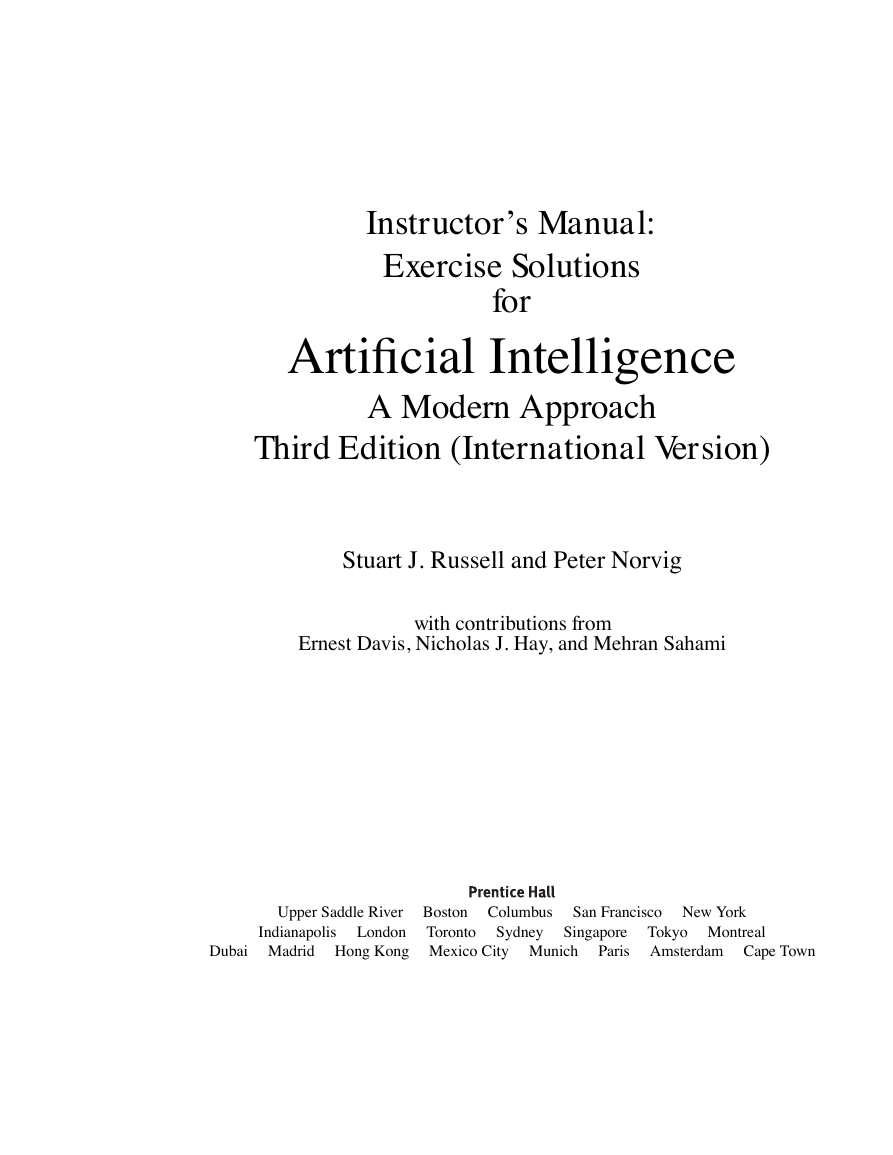
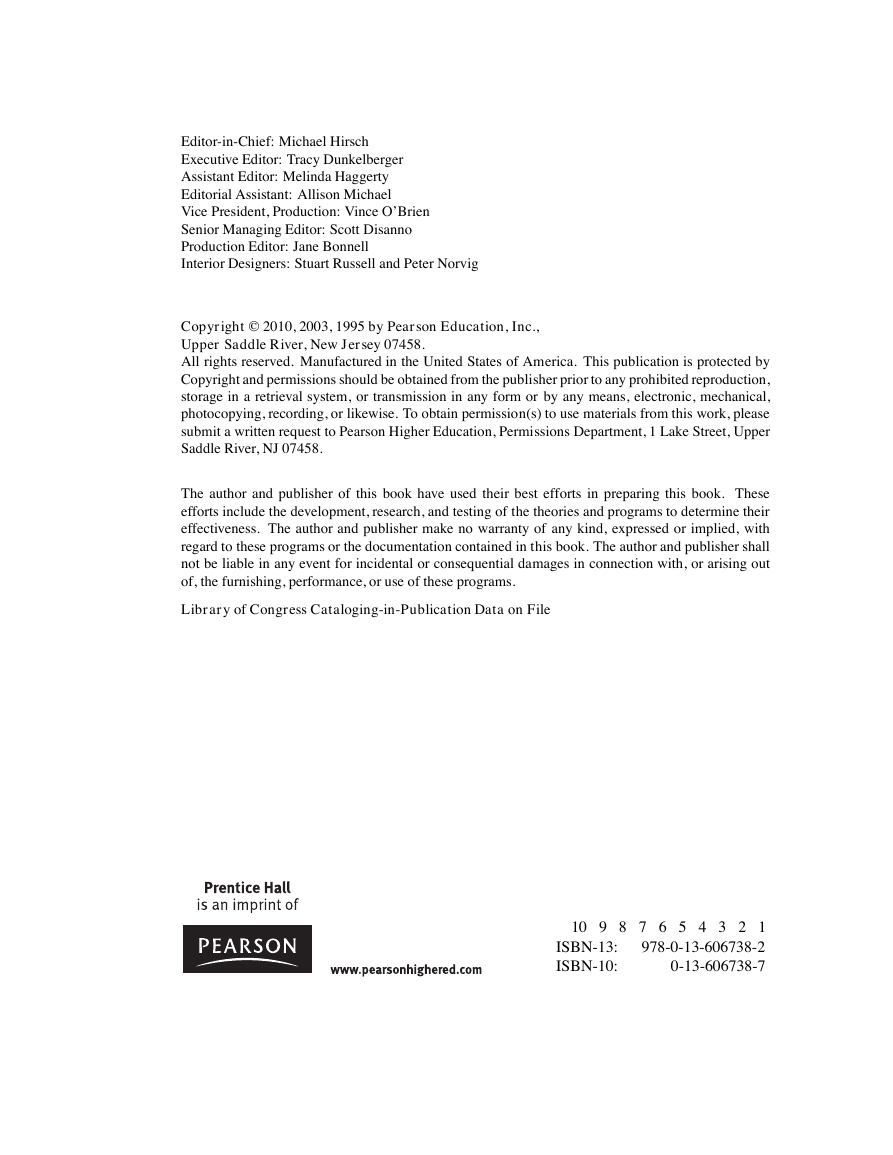
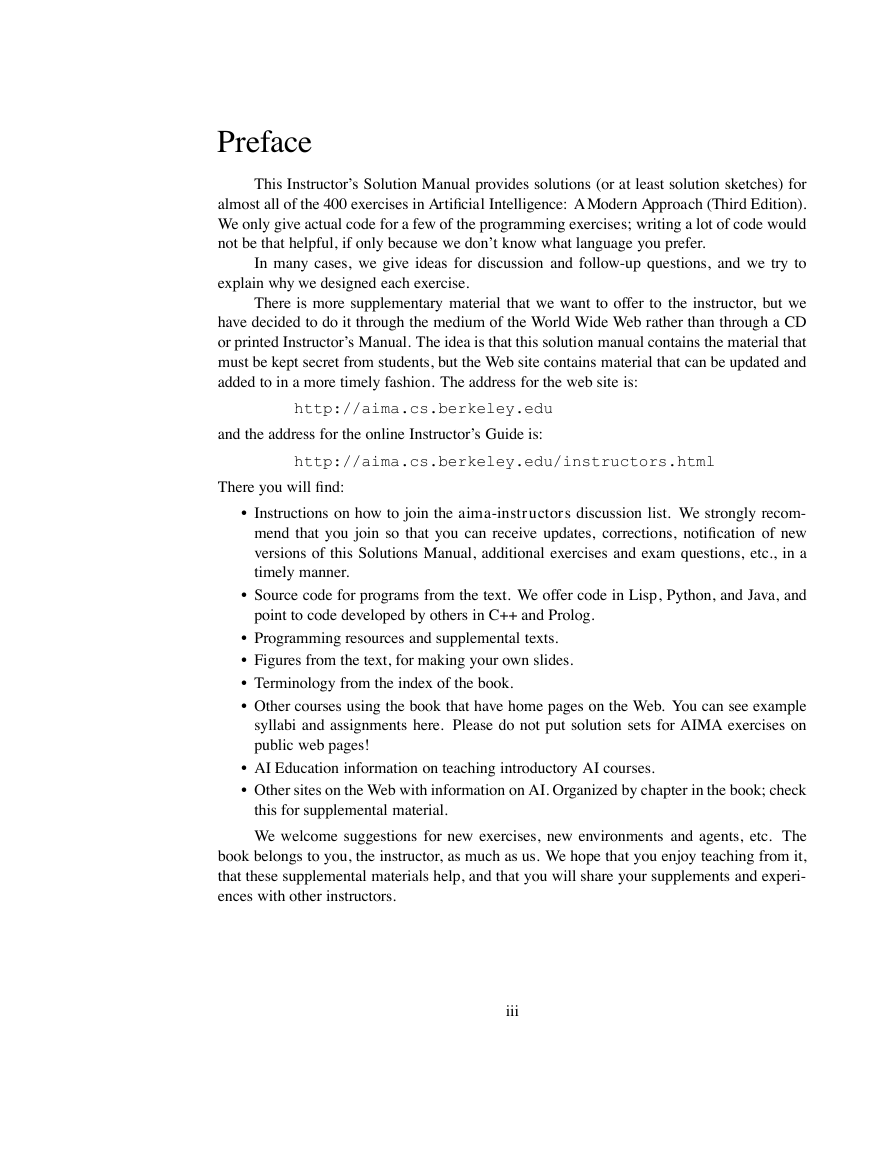



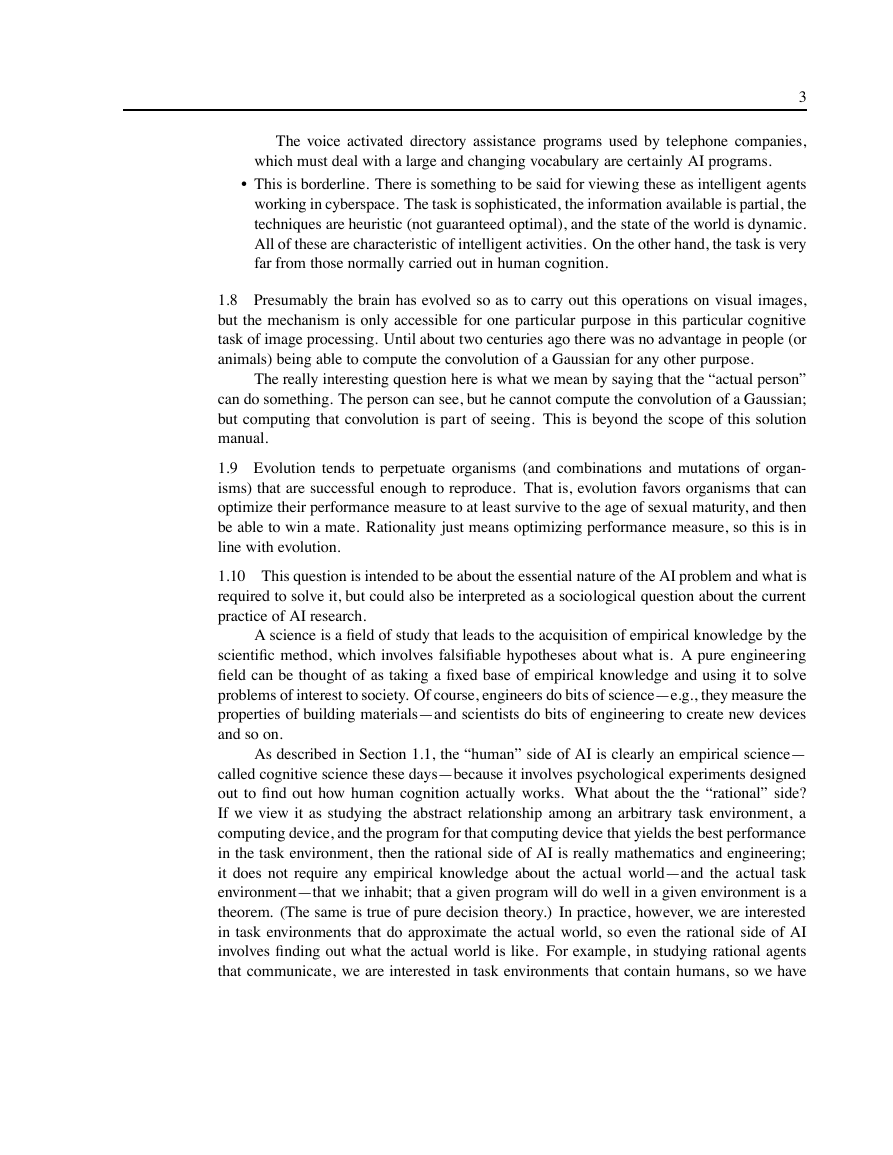
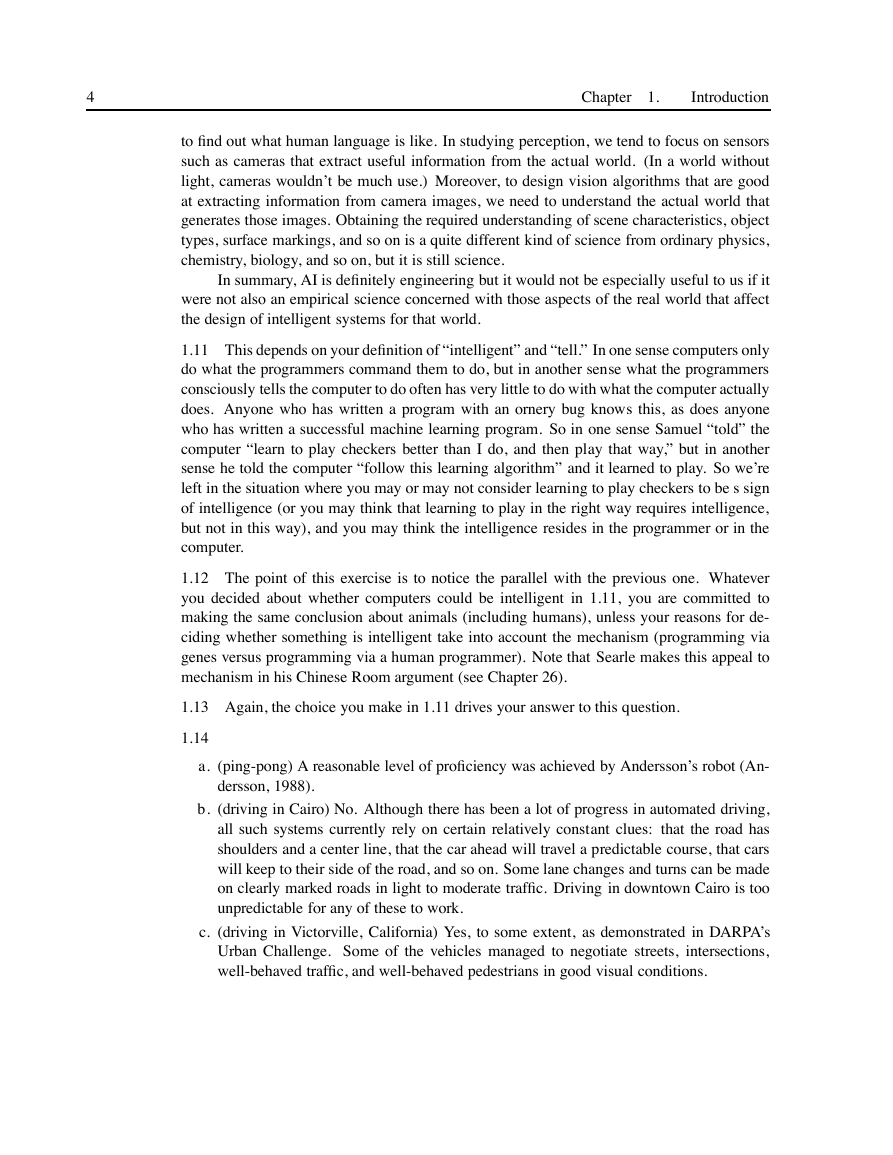








 2023年江西萍乡中考道德与法治真题及答案.doc
2023年江西萍乡中考道德与法治真题及答案.doc 2012年重庆南川中考生物真题及答案.doc
2012年重庆南川中考生物真题及答案.doc 2013年江西师范大学地理学综合及文艺理论基础考研真题.doc
2013年江西师范大学地理学综合及文艺理论基础考研真题.doc 2020年四川甘孜小升初语文真题及答案I卷.doc
2020年四川甘孜小升初语文真题及答案I卷.doc 2020年注册岩土工程师专业基础考试真题及答案.doc
2020年注册岩土工程师专业基础考试真题及答案.doc 2023-2024学年福建省厦门市九年级上学期数学月考试题及答案.doc
2023-2024学年福建省厦门市九年级上学期数学月考试题及答案.doc 2021-2022学年辽宁省沈阳市大东区九年级上学期语文期末试题及答案.doc
2021-2022学年辽宁省沈阳市大东区九年级上学期语文期末试题及答案.doc 2022-2023学年北京东城区初三第一学期物理期末试卷及答案.doc
2022-2023学年北京东城区初三第一学期物理期末试卷及答案.doc 2018上半年江西教师资格初中地理学科知识与教学能力真题及答案.doc
2018上半年江西教师资格初中地理学科知识与教学能力真题及答案.doc 2012年河北国家公务员申论考试真题及答案-省级.doc
2012年河北国家公务员申论考试真题及答案-省级.doc 2020-2021学年江苏省扬州市江都区邵樊片九年级上学期数学第一次质量检测试题及答案.doc
2020-2021学年江苏省扬州市江都区邵樊片九年级上学期数学第一次质量检测试题及答案.doc 2022下半年黑龙江教师资格证中学综合素质真题及答案.doc
2022下半年黑龙江教师资格证中学综合素质真题及答案.doc